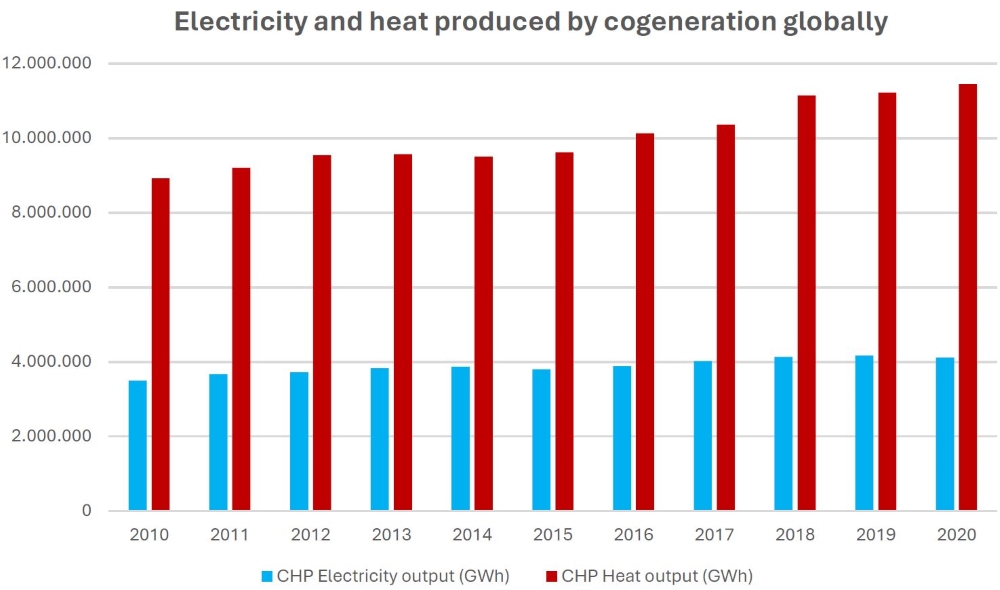
CWC’s 2nd Global Market Report confirms growing use of cogeneration technologies around the world
The COGEN World Coalition (CWC), which represents major players in cogeneration (also known as combined heat and power or CHP), is today publishing its second annual report on the Global Cogeneration Market. The report shows that the total capacity of CHP plants and installations worldwide, in terms of their combined heat output, has increased by more than 25% since 2010.
The second edition of CWC’s Global Cogeneration Market Overview was produced for CWC by Challoch Energy. It describes the state of the cogeneration market around the world using data published by the International Energy Agency (IEA) in 2022, complemented by data published by Eurostat (the statistical office of the European Union) in 2023.
The data presented in the market overview show that global CHP capacity grew by around 18% (in terms of electricity generated) or 28% (in terms of heat output) over the 10-year period from 2010 until 2020. According to the latest data (from 2020), the annual output of CHP systems globally amounts to 11,449 TWh of heat and 4,119 TWh of electricity, which represents just over 15% of total electricity generation. CHP systems are primarily being driven by fossil fuels, especially coal and coal products (59.6%) and natural gas (31.8%).
Asia-Pacific, Europe and North America are the regions with the most developed markets for cogeneration technologies. CHP systems are widely used in energy-intensive industries such as chemicals, pulp and paper, as well as food and drink, and they are increasingly being deployed to provide electricity and heat for facilities such as hospitals and universities, as well as district heating and cooling networks.
Biofuels and waste contribute a significant and growing share of the fuel mix. Although these sources only represent 6.7% of energy input to CHP systems globally, there is wide variation between different regions and countries. Biofuels and waste account for 73% of the fuel mix in South America, 29% in Africa and 11% in Europe.
As well as describing the existing situation, the Global Cogeneration Market Overview also presents a forecast of future trends:
- Demand for cogeneration technologies is expected to continue growing in Asia (especially in China and India) as well as in South America and North America (notably thanks to financial incentives offered by the US Government under the Inflation Reduction Act of 2022).
- The policy and regulatory environment will continue to encourage a switch from coal to natural gas, together with an ever-increasing use of clean and renewable energy sources such as solar thermal, geothermal, biofuels and hydrogen.
- Cogeneration will remain important for those industries that require a continuous supply of heat, and there is significant scope for expanding the use of CHP to provide electricity and heat for residential and commercial buildings, district heating networks and public facilities (hospitals, universities, etc.)
- We expect to see a growing market for smaller CHP installations (up to 10 MW capacity), as well as cogeneration systems that use Fuel Cells.
“CWC’s Global Cogeneration Market Overview gives a picture of how CHP technologies are being used in different regions of the world,” says Hans Korteweg, CWC’s Executive Director. “For example, it shows that natural gas is currently the number one fuel being used in CHP installations across Europe and North America, whereas biofuels and waste are the most important energy source in South America, while coal continues to dominate in China and the rest of Asia. This mixed picture underlines our message that CHP can deliver enhanced energy efficiency, irrespective of which fuel one is using. Looking to the future, we believe that cogeneration technologies will play a central role in making the most efficient use of renewable and low-carbon fuels.”
“This is a really exciting time for the cogeneration sector,” says Thomas Smith, the President of CWC. “Already today, cogeneration technologies are delivering major benefits to industry and other energy users in terms of efficiency, cost effectiveness and resiliency. For the future, as we head towards the goal of net zero emissions, CHP has an integral part to play in making the most efficient use of new fuels such as clean hydrogen, biogas and biomethane (also known as RNG). We also see a continuing role for natural gas to be used instead of coal and increasingly in combination with carbon capture, utilization and sequestration (CCUS). Regardless of which fuel is being used, cogeneration represents the most efficient solution for turning that fuel into useful energy – both in the form of heat and as electrical power.”
Read the CWC Report: Global Cogeneration Market Overview (2nd Edition – December 2023)
The main findings of the CWC’s 2nd Global Cogeneration Market Report were presented during a live webinar on 18 December 2023. You can watch the webinar recording on the CWC’s YouTube channel.
Published: 20 December 2023
